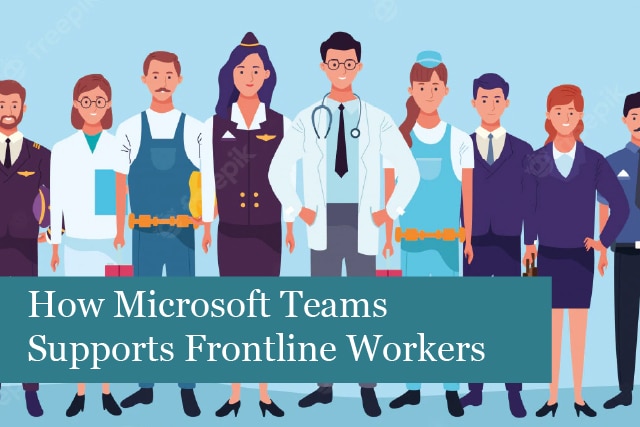
There’s no question that frontline workers play a key role in the economy. These are the people on the frontlines of the workforce who need technology to support them in their work. In recent months, Microsoft has added some new features to Teams that make it easier for frontline workers to connect with customers, schedule meetings, and more. Frontline employees now have a more useful platform to care for themselves, their clients, and their teams.
We’ve created a list of ways that frontline workers can benefit from Microsoft Teams. Read on to learn how Teams can help your team to better connect and help customers.
Who are Frontline Employees?
According to Tech Republic, about 80% of the global workforce is frontline employees. These are employees who work in retail, hospitality, healthcare, and other industries. These are usually employees who can’t work from home, and they are not tied to a desk and computer most of the day.
So, frontline employees include doctors, nurses, employees in manufacturing companies, retail employees, and wait staff in the hospitality industry. These employees usually don’t have good tools to stay in touch with colleagues or management, and this is where Microsoft Teams comes in.
Microsoft Teams Features that Help Frontline Workers
More companies are faced with remote team members who are stationed across the country. With a growing remote workforce, businesses are looking for ways to keep their teams together and reproduce company culture and community with their remote teams. These are the reasons many companies are turning to Microsoft Teams for their communication tools.
Connecting Teams & Communities
Microsoft Teams is an ideal communication tool that makes communication so much easier. But why? Teams helps with communication in the following ways :
Effective communication with a specific audience: Teams makes it easy to tag team members by categories, including role or department. This feature makes it easier to share specific information about updates, news, policies, and more with the right people and only them. Keeping information only for specific groups is also in line with security and IT regulations and compliance for some industries, especially those on data access and management.
Sharing information in real-time: the tool’s Smart Camera feature also makes it easy for users to annotate and send images to one another. What’s more, Teams also has in-line translators so employees can communicate across languages and cultures. It’s also possible to notify the team with priority notifications, so no one misses essential information.
Supports hands-free & heads-up talk features: Teams also features a push-to-talk service that turns phones and tablets into walkie-talkies. This way, teams can speak with colleagues in real-time. What’s more, the feature is easy to use and secure, and it works with WiFi or cellular data.
Scheduling & Attendance
One prevalent problem that many employees struggle with is scheduling meetings and everyone showing up on time or at all. Scheduling and attendance problems are common due to outdated scheduling software, challenges calculating time zones, and more. Another issue is the need to update schedules. All of this leads to problems with scheduling and attending meetings.
However, Teams offers features that help with these issues:
Supports digital and mobile scheduling tools: Teams offers the Shifts scheduling app that makes it easier for managers to plan schedules by making one from scratch or importing one from Excel. Shifts also make it easier for employees to track their schedules, ask for time off, and generally plan ahead.
Tracking time & attendance: the Teams app also offers Time Clock that can be used to ensure employees clock in from a designated worksite at the scheduled time. The process becomes automated, allowing managers to have a better idea of their employees’ work, locations, and progress.
Task Management
Task management across a team with multiple shifts, site locations, and staff teams is also a challenge for managers. These issues make it more challenging to track the status and completion of tasks. However, Teams helps task management in these ways:
Distributing tasks from corporate to frontline workers: Teams make it easier to create a task list and publish it to several locations and then assign a manager who can distribute the task to their employees with clear instructions. Everyone tagged on the task can monitor the progress in real-time as corporate headquarters, and managers get instant visibility of task status.
Centralised project approvals: Teams also makes it easier for frontline workers to collaborate, create, manage, and share approvals from a chat. This creates a record and provides context for current projects.
Making tasks more straightforward: companies can more easily track tasks in one place with Teams. When the task is done, the frontline workers can attach a photo to show the completed work. It’s also easy to attach additional documentation if needed.
Community Engagement
Businesses are dealing with increased employee burnout and turnover. So, they’re looking for better ways to support their employees, and company culture, and offering employee development initiatives. The goal is to create a positive community to ease some of these issues.
Teams can also help companies and their employees engage more using these features:
Virtual Town Hall meetings: employees can meet one another through Town Hall meetings hosted through Teams Live Events. The meetings can be a great place for upper management to share company goals, policies, and news with employees. And employees can network with one another, ask questions, and provide feedback in real-time.
Employee development: Teams also makes it easier to offer employee development initiatives through SharePoint, Stream, and Yammer. Businesses can create content and communities for employee learning. This is also a great way for businesses to invest in learning to help their employees gain new opportunities within their organisation. It also enables collaboration across different departments.
Rewards: Teams can also be used to help recognise employee accomplishments by boosting morale. The tool provides customisable praise badges that highlight leadership, team work, inclusivity, creativity, and more.
Summing It Up
There’s no question that frontline employees across many industries require better tools for their work. Microsoft Teams has become a tool that can be used in the office, in the hospital, on the manufacturing floor, and more.
Microsoft Teams updates have made this an effective tool for communication, tracking hours, tasks in projects, and more. The software offers a viable solution for those frontline employees who are not usually connected to each other or management in any other way.
Recommended Posts

10 Biggest Cybersecurity Mistakes of Small Companies
18th April 2025

The Importance of Planning in Business IT Solutions
11th April 2025

